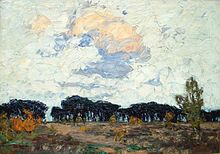Otto Altenkirch

Otto Altenkirch (born January 2, 1875 in Ziesar , district of Jerichow I , Province of Saxony , Prussia ; † July 20, 1945 in Siebenlehn , district of Meißen , Saxony ) was a German painter and set designer. He is one of the main representatives of late Impressionist landscape painting in Saxony.
Life
Altenkirch was the sixth child of master saddler Johann Christian Friedrich Altenkirch and his wife Dorothea Wilhelmine Auguste nee. Müller was born and grew up in simple circumstances. After attending primary school in Ziesar, he began a four-year apprenticeship as a decorative painter in Berlin in 1889 , which he completed with honors. He initially stayed in Berlin and worked as a journeyman painter. He also took drawing lessons from Hugo Händler at the voluntary advanced training school . A study trip and his military service took him to Eastern Europe and East Prussia in the following years. Finally he returned to Berlin in 1897.
In the summer of 1898 he began to study painting at the Academy of Fine Arts , initially as a trainee with Paul Prozess , from November 1900 as a full-time student in Eugen Bracht's class . When he went to the Dresden Art Academy in 1902 , Altenkirch followed him. The following year he officially became Bracht's assistant.
The first exhibitions followed, such as the Academy's student exhibition in 1903, where he was awarded a large silver medal, and in 1904 a joint exhibition with Richardt Anschütz and Otto Heinrich Engel in the Emil Richter art salon . At Easter 1906 he finished his studies with distinction and settled in Dresden as a freelance artist. After initially joining the artist community Die Elbier , he was a founding member of the Dresden Artists' Association in 1910 .
On February 1, 1910, he was employed as a chief court theater painter at the Royal Saxon Court Theaters. His creations included u. a. the stage sets for the Dresden premiere of Richard Wagner's Parsifal and for the performance of the Ring des Nibelungen on the occasion of Wagner's 100th birthday in 1913. Altenkirch competed in an artistic competition with his impressionistic landscapes, which clearly stood out from Wagner's detailed and naturalistic descriptions, previously prevailed against well-known competitors such as Max Klinger and Lovis Corinth . For his services as a stage designer, the Saxon King Friedrich August III awarded him on June 16, 1917 . the title of professor.
At the beginning of 1920 Altenkirch gave up his professional activity, left Dresden and settled down as a painter in the small town of Siebenlehn, where his father-in-law had given him a house. The main creative period as a painter began in this environment. Over the years he repeatedly painted some of his groups of motifs and placed them in the context of the seasons. For more than two decades, the Reinsberger Lindenallee was a motif that he repeatedly dealt with intensively and of which he made series of pictures. A few weeks before his death in July 1945, Altenkirch completed his last large oil painting, the motif of which is the garden of his Siebenlehner Landgasthaus St. Romanus.
literature
- Walter Kunze: Altenkirch, Otto. In: New German Biography (NDB). Volume 1, Duncker & Humblot, Berlin 1953, ISBN 3-428-00182-6 , p. 215 ( digitized version ).
Web links
- Literature by and about Otto Altenkirch in the catalog of the German National Library
- Otto Altenkirch , website
- Group picture: Altenkirch with Richard Strauss, Ernst v. Schuch, Max Reinhardt, Hugo v. Hofmannsthal, Nikolaus Graf von Seebach a. a.
Individual evidence
- ↑ Bernd Klempnow: When the desert blooms , in: Sächsische Zeitung, March 13, 2013
| personal data | |
|---|---|
| SURNAME | Altenkirch, Otto |
| BRIEF DESCRIPTION | German painter |
| DATE OF BIRTH | January 2, 1875 |
| PLACE OF BIRTH | Ziesar |
| DATE OF DEATH | July 20, 1945 |
| Place of death | Siebenlehn |

